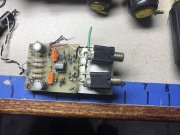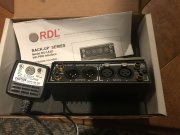I’ve been reading up on the ways to eliminate dc
here is one interesting thought:
Lets look at stopping DC from a source component. This shows a series cap and a resistor to ground. Typical values would be a small 0.47uf film type cap and a 470k resistor. This ensures that whatever DC is present on the source does not get past the cap. The output is always 0.0000 volts DC.
I would try something like this first just for the DAC feed and see how you get on. Also, for interest you could try and measure any DC voltage present. It may only be a millivolt or two but you might see something and be able to compare channels.
Its also important that the power amp input doesn't see any large change in DC resistance to ground as the input is switched as that can also cause a pop.
Edit... the cap value also depends on what impedance the power amp presents and so 0.47uf may be a bit small. Used correctly, and a small and cheap electrolytic can be very suitable if you need larger values.
And another approach
A line level output coupling cap needs to be terminated with a resistor to ground, like Mooly's drawing. Otherwise, there will be a DC voltage on the output until it is connected to a resistive load (like the input of a preamp or power amp). Then the DC voltage will drop to zero, and you will hear a pop or thump.
Try a 100K resistor in parallel with that input on your preamp switch. If your problem is what I described, then this will cure it.
and this
both preamp and the power amp should each be AC coupled at their inputs. If you use a switching arrangement as you describe (not the grounds bit though) then each input should be treated separately and each have its own cap (and resistor to ground) rather than just one cap at the preamp input. Why so. Because one cap would still cause pops if there were DC present on any input, and it would do that because the cap would see a sudden step change in voltage as the switch operated. Defining each input from the start ensures they are all at zero volts and so that is what the switch and preamp input see.
2/ Its not common practice to switch grounds. If it were not done correctly then there is a possibility of a ground floating momentarily as the switch operates causing more than just a small pop.



